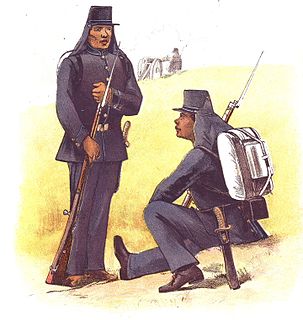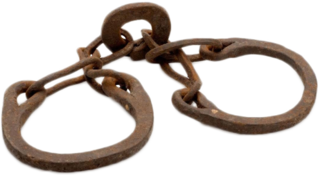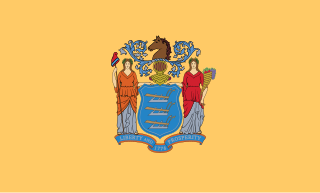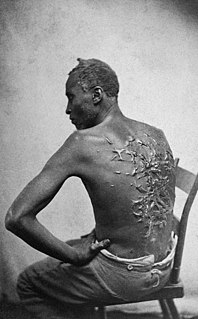 W
WAbolitionism, or the abolitionist movement, was the movement to end slavery. This term can be used both formally and informally. In Western Europe and the Americas, abolitionism was a historic movement that sought to end the Atlantic slave trade and set slaves free.
 W
WThe history of African-American settlement in Africa extends to the beginnings of ex-slave repatriation to Africa from European colonies in the Americas.
 W
WAfro-Puerto Ricans are Puerto Ricans who are of predominant or partial African descent. The history of Puerto Ricans of African descent begins with free African men, known as libertos, who accompanied the Spanish Conquistadors in the invasion of the island. The Spaniards enslaved the Taínos, many of whom died as a result of new infectious diseases and the Spaniards' oppressive colonization efforts. Spain's royal government needed laborers and began to rely on slavery to staff their mining and fort-building operations. The Crown authorized importing enslaved West Africans. As a result, the majority of the African peoples who entered Puerto Rico were part of the forced migration of the Atlantic slave trade, and came from many different cultures and peoples of the African continent.
 W
WAmerican Colonization Society (ACS), originally known as the The Society for the Colonization of Free People of Color of America, was founded in 1816 by Robert Finley to encourage and support the migration of free African Americans to the continent of Africa.
 W
WBelanda Hitam were a group of African recruits in the Royal Netherlands East Indies Army during the colonial period.
 W
WBlack in Latin America is a documentary television series that aired on PBS on April 19, 2011 in the United States. The series is based on the 2011 book Black in Latin America by Henry Louis Gates Jr., who produced the four-episode series. Both the documentary and book explore the historical roots and influence of Afro-Latin Americans. The book's chapters and the documentary's episodes each focus on individual Latin American countries whose African heritage is often overlooked. Each nation has varying perceptions of race and color, but all had policies in order to lighten the overall skin color of their population. For example, in 1933 Mexico restricted the immigration of blacks into the country, and 4 million white European immigrants were welcomed to Brazil between 1884 and 1939.
 W
WBoley is a town in Okfuskee County, Oklahoma, United States. The population was 1,184 at the 2010 census, a gain of 5.2 percent from the figure of 1,126 recorded in 2000. Boley was established in 1903 as a predominantly Black pioneer town with persons having Native American ancestry among its citizens. Boley is currently home to barbeque equipment maker, Smokaroma, Inc, and the John Lilley Correctional Center.
 W
WThe breeding of enslaved people in the United States was the practice in slave states of the United States of slave owners to systematically force the reproduction of enslaved people to increase their profits. It included coerced sexual relations between enslaved men and women, forced pregnancies of enslaved people, and favoring women who could produce a relatively large number of children. The objective was to increase the number of enslaved people without incurring the cost of purchase, and to fill labor shortages caused by the termination of the Atlantic slave trade.
Brooksville is a town in Pottawatomie County, Oklahoma, United States. It is one of the thirteen existing all-black towns in Oklahoma. The population was 63 at the 2010 census, a 30 percent decline from the figure of 90 in 2000.
Clearview is a town in Okfuskee County, Oklahoma, United States. The population was 56 at the 2000 census. It was historically an all-black freedmen's town and was platted by the Lincoln Townsite Company and designated as Lincoln.
 W
WThe Committee for the Relief of the Black Poor was a charitable organisation founded London in 1786 to provide sustenance for distressed people of African and Asian origin. It played a crucial role in the proposal to form a colony for black refugees in Sierra Leone. The work of the Committee overlapped to some extent with the campaign to abolish slavery throughout the British Empire.
 W
WThe First Pan-African Conference was held in London from 23 to 25 July 1900. Organized primarily by the Trinidadian barrister Henry Sylvester Williams, it took place in Westminster Town Hall and was attended by 37 delegates and about 10 other participants and observers from Africa, the West Indies, the US and the UK, including Samuel Coleridge-Taylor, John Alcindor, Dadabhai Naoroji, John Archer, Henry Francis Downing, and W. E. B. Du Bois, with Bishop Alexander Walters of the AME Zion Church taking the chair. Du Bois played a leading role, drafting a letter to European leaders appealing to them to struggle against racism, to grant colonies in Africa and the West Indies the right to self-government and demanding political and other rights for African Americans.
Grayson is a town in Okmulgee County, Oklahoma, United States. The population was 159 at the 2010 census, an increase of 18.7 percent from the figure of 134 recorded in 2000.
 W
WThe first African Americans to arrive in Utah were fur trappers in the early 19th century. The second influx consisted of both freedmen who were converts to The Church of Jesus Christ of Latter-day Saints and slaves belonging to white converts. Later, most African American immigrants to Utah would migrate out for labor-related motivations. African Americans have traditionally been composed only a small part of the total population in Utah, with the 2010 census placing the percentage of African Americans at 1.06%. Utah ranks 40th in the United States for total African American population and 43rd in percentage of residents who are African American.
 W
WSlavery in New Jersey began in the early 17th century, when Dutch colonists trafficked African slaves for labor to develop their colony of New Netherland. After England took control of the colony in 1664, its colonists continued the importation of slaves from Africa. They also imported "seasoned" slaves from their colonies in the West Indies and enslaved Native Americans from the Carolinas.
 W
WThe systematic enslavement of African people in the United States began in New York as part of the Dutch slave trade. The Dutch West India Company imported eleven African slaves to New Amsterdam in 1626, with the first slave auction held in New Amsterdam in 1655. With the second-highest proportion of any city in the colonies, more than 42% of New York City households held slaves by 1703, often as domestic servants and laborers. Others worked as artisans or in shipping and various trades in the city. Slaves were also used in farming on Long Island and in the Hudson Valley, as well as the Mohawk Valley region.
Langston is a town in Logan County, Oklahoma, United States, and is part of the Oklahoma City Metropolitan Statistical Area. The population was 1,724 at the 2010 census, an increase of 3.2 percent from the figure of 1,670 in 2000. Langston is home to Langston University, the only historically black college in Oklahoma.
Lima is a town in Seminole County, Oklahoma, United States. The population was 53 at the 2010 census, a 28.4 percent decline from the figure of 74 recorded in 2000.
 W
WMississippi-in-Africa was a colony on the Pepper Coast founded in the 1830s by the Mississippi Colonization Society of the United States and settled by American free people of color, many of them former slaves. In the late 1840s, some 300 former slaves from Prospect Hill Plantation and other Isaac Ross properties in Jefferson County, Mississippi, were the largest single group of emigrants to the new colony. Ross had freed the slaves in his will and provided for his plantation to be sold to pay for their transportation and initial costs.
Redbird is a town in Wagoner County, Oklahoma, United States. The population was 137 at the 2010 census, a 10.5 percent decline from the figure of 153 in 2000. Founded at the turn of the 20th century, it was one of more than fifty all-black towns in Oklahoma Territory and Indian Territory and is one of thirteen surviving black communities in Oklahoma..
Rentiesville is a town in McIntosh County, Oklahoma, United States. It was founded in 1903 and named for William Rentie, a local landowner. It was one of 50 all-black towns in Oklahoma and one of 13 that still survives. The population was 128 at the 2010 census, an increase of 25.5 percent from 102 in 2000.
 W
WThe Republic of Maryland was a country in West Africa that existed from 1834 to 1857, when it was merged into what is now Liberia. The area was first settled in 1834 by freed African-American slaves and freeborn African Americans primarily from the U.S. state of Maryland, under the auspices of the Maryland State Colonization Society.
 W
WThe Slave's Cause: A History of Abolition is a historical book by Manisha Sinha that was released in February 2016 by Yale University Press.
 W
WSlavery in the United States was the legal institution of human chattel enslavement, primarily of Africans and African Americans, that existed in the United States of America from its founding in 1776 until passage of the Thirteenth Amendment in 1865. Slavery was established throughout European colonization in the Americas. From early colonial days, it was practiced in Britain's colonies, including the Thirteen Colonies which formed the United States. Under the law, an enslaved person was treated as property and could be bought, sold, or given away. Slavery lasted in about half of U.S. states until 1865. As an economic system, slavery was largely replaced by sharecropping and convict leasing.
Summit is a town in Muskogee County, Oklahoma, United States. It was originally called South Muskogee when it was platted in 1910, and is one of thirteen all-black towns still surviving at the beginning of the 21st Century. The population was 139 at the 2010 census, a 38.5 percent decline from the figure of 226 recorded in 2000.
Taft is a town in Muskogee County, Oklahoma, United States. The population was 250 at the 2010 census, a decline of 28.4 percent from the figure of 349 recorded in 2000. The town began as an all-black town on land allotted to Creek Freedmen. It is named for President William Howard Taft.
Tatums is a historic Freedmen's town in Carter County, Oklahoma, United States. The population was 151 at the 2010 census, a decline of 12.2 percent from the figure of 172 in 2000. It is part of the Ardmore, Oklahoma Micropolitan Statistical Area.
 W
WThe treatment of enslaved people in the United States varied by time and place, but was generally brutal, especially on plantations. Whipping and rape were routine, but usually not in front of white outsiders, or even the plantation owner's family. An enslaved person could not be a witness against a white; enslaved people were sometimes required to whip other enslaved people, even family members. There were also businesses to which a slave owner could turn over the whipping. Families were often split up by the sale of one or more members, usually never to see or hear of each other again. There were some relatively enlightened slave owners—Nat Turner said his master was kind—but not on large plantations. Only a small minority of enslaved people received anything resembling decent treatment; one contemporary estimate was 10%, not without noting that the ones well treated desired freedom just as much as those poorly treated. Good treatment could vanish upon the death of an owner. As put by William T. Allan, a slaveowner's abolitionist son who could not safely return to Alabama, "cruelty was the rule, and kindness the exception".
Tullahassee is a town in Wagoner County, Oklahoma, United States. The population was 106 in both the 2010 and the 2000 censuses. It was the location of Tullahassee Mission. Tullahassee is considered the oldest of the all-black towns in Oklahoma.
 W
WVernon is an unincorporated community in McIntosh County, Oklahoma, United States. Its elevation is 696 feet (212 m).